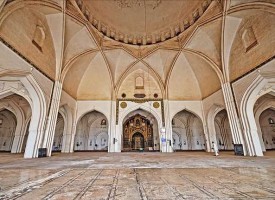“He came at a time when people stood in dire need of replies against the philosophers than the darkest night stands in need of the light of the moon and stars.”
The tenth century was a time of great strife between reason and revelation in the Muslim world. This was the time when one of the most celebrated scholars, philosophers and jurists of Islamic history, Abû Hâmid Muhammad ibn Muhammad al-Ghazâlî was born. Most accounts state that he was born in 1058 or 1059 in Tûs, which is north of present day Mashad, in Iran. However, according to his autobiography, he was born in 1055 or 1056.
Early Life and Education
Al-Ghazâlî began his education around six or seven years of age in his home town. He studied the Qur’an, the principles of religion, Arabic, Persian and later continued with the study of fiqh, tafsir and hadith. After studying for seven or eight years in Tûs, he moved to Jurjan, which was a center of learning at the time. There he studied fiqh from Imam al-Isma‘Ili for about a year and then returned to Tûs where he stayed for three years. Afterwards, he moved to Nishapur to further his knowledge and study fiqh, kalam and logic at the Nizâmiyya Madrasa, the most prominent center of knowledge in the East at the time, under Imam Abu al-Ma‘ali al-Juwayni, who was one of the most prominent Shafi‘i faqqih’s of his time. He studied with al-Juwayni for five years until the death of his shaykh in 1085 when Imam Ghazâlî was 28 years old.
The period he spent at Madrasa Nizâmiyya had far reaching implications on his life in general and political career in particular. During his stay there, he became closely associated with the court of the Seljuq Sultan Malikshâh and his famous minister Nizâm al-Mulk. Imam Ghazâlî was appointed at the prestigious Nizâmiyya Madrasa in Baghdad by Nizâm al-Mulk. His association with the court of Sultan Malikshâh connected him with the Caliphate as well. Al-Ghazâlî remained associated with the court of Seljuq Sultan for six years and served as the court faqqih (jurist) and also taught at the Nizâmiyya Madrasa.
Al-Ghazâlî’s Major Contributions to his Time
He played the central role in addressing the two primary political as well as intellectual controversies of his time. He was at the forefront of the struggle between religion and philosophy and in the battle against the influence of the Batinites.
Since the early 10th century, the Muslim world was confronted by the philosophical works of al-Fârâbî and then of Ibn Sina (Avicenna), which challenged the beliefs held by Muslim theologians. The two most important areas were the beginning and creation of the world and the nature of wahi (divine revelation to the prophets). One of Imam Ghazâlî’sprimary concerns was to reconcile philosophy with religion. He presented a summary of the philosophical thought prevalent in his time in his book Maqasid al-Falasifa. This book was the precursor to his famous work on philosophy, Tahafut al-Falasifa (The Incoherence of the Philosophers). In this book, he presented his arguments in the form of 20 points, to oppose the prevalent philosophical thought.
The brilliant Imam mastered the techniques of Neoplatonic and Aristotelian logic and used these techniques to lay bare the flaws and inconsistencies within these very methods. He proved how it is not possible for limited human reason to comprehend the infinite, i.e. Allah. Thus with his clarity of thought and forceful arguments he defined the limits and boundaries of religion and reason.
Ihya Ulum al-Din (The Revival of the Religions Sciences) is considered to be al-Ghazali’s Magnus Opus. This book consists of 40 chapters, which are divided into four volumes comprising of approximately 1500 pages. The first part discusses the rituals and other requirements of Islam such as prayer, fasting, purity etc. The second part talks about the matters of the person and society including marriage, work etc. The third part is about the inner life and the vices that impede the way of obtaining eternal success. The fourth part discusses the virtues that help in overcoming the vices.
“It was as if Allah gathered all sciences under a dome, and showed them to al-Ghazzali.” Fakhr al-Din al-Razi
Al-Ghazâlî’s Transformation into a Sufi
At the age of 38, Imam Ghazâlî experienced a spiritual crisis as his spiritual self fervently questioned the rational self. It made him doubt the validity of the tools of knowledge and the knowledge thus acquired. After six months of internal strife, he finally saw the light and renounced all of his worldly possessions including the teaching job at the Madrasa Nizâmiyya. This was the birth of Al- Ghazâlî ‘the Sufi’. He became convinced that it is not possible to reconcile the realities and knowledge of this world with the hereafter by using reason. For him, revelation superseded reason. At this juncture, he left Baghdad and set out for a pilgrimage to Mecca.
He had Sufi influences in his life from the very beginning as his father was partial to Sufism; his brother was a prominent scholar and Sufi of his time, and among his teachers were also renowned Sufis.
The next two years of his life were spent wandering the land between Damascus, Jerusalem and Mecca. He lived a life of seclusion and withdrawal from the world learning and practicing the Sufi way of life.
The Final Years
Imam Ghazâlî returned to Baghdad as a Sufi in 1097 and started teaching and then after a brief period, moved back to his birthplace. After about seven years, he again returned to Baghdad in 1104 and started teaching at the Nizâmiyya madrasa. But five years later, he moved to Tûs for the last time and lived the rest of his life practicing and teaching Sufism.
This great scholar met his creator in 1111. Thus came to an end the life of Sharaful A’imma (the Chief of the Scholars), Zainuddin (The Beauty of the Deen), and Hujjatul Islam (the Proof of Islam).








I’m annoyed at the choice of illustration for Imam Ghazali, who was a staunch follower of the sunnah, and wore the turban as his headgear. This image makes him appear as a post-modern renaissance artist. You should not have an illustration for him, as there were none- this artist depiction is dishonest.